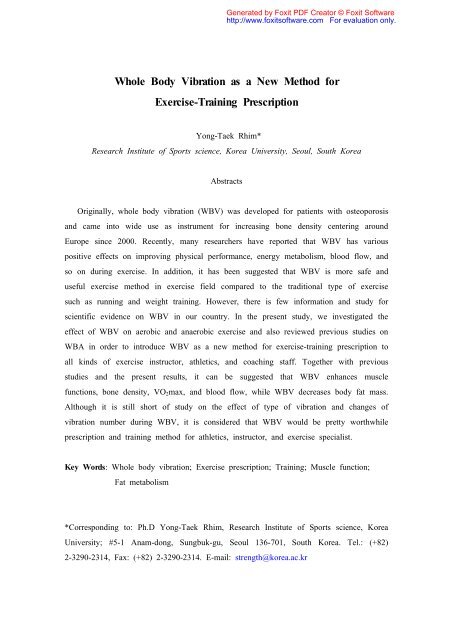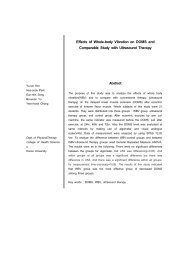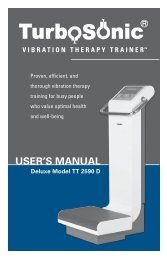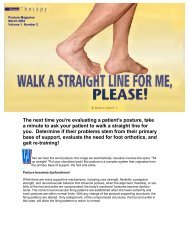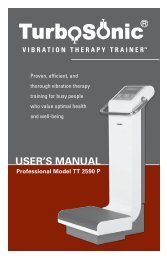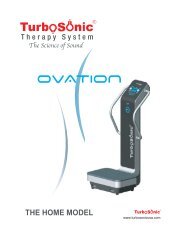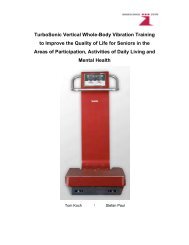Whole Body Vibration As A New Method For Exercise ... - TurboSonic
Whole Body Vibration As A New Method For Exercise ... - TurboSonic
Whole Body Vibration As A New Method For Exercise ... - TurboSonic
You also want an ePaper? Increase the reach of your titles
YUMPU automatically turns print PDFs into web optimized ePapers that Google loves.
Generated by Foxit PDF Creator © Foxit Software<br />
http://www.foxitsoftware.com <strong>For</strong> evaluation only.<br />
<strong>Whole</strong> <strong>Body</strong> <strong>Vibration</strong> as a <strong>New</strong> <strong>Method</strong> for<br />
<strong>Exercise</strong>-Training Prescription<br />
Yong-Taek Rhim*<br />
Research Institute of Sports science, Korea University, Seoul, South Korea<br />
Abstracts<br />
Originally, whole body vibration (WBV) was developed for patients with osteoporosis<br />
and came into wide use as instrument for increasing bone density centering around<br />
Europe since 2000. Recently, many researchers have reported that WBV has various<br />
positive effects on improving physical performance, energy metabolism, blood flow, and<br />
so on during exercise. In addition, it has been suggested that WBV is more safe and<br />
useful exercise method in exercise field compared to the traditional type of exercise<br />
such as running and weight training. However, there is few information and study for<br />
scientific evidence on WBV in our country. In the present study, we investigated the<br />
effect of WBV on aerobic and anaerobic exercise and also reviewed previous studies on<br />
WBA in order to introduce WBV as a new method for exercise-training prescription to<br />
all kinds of exercise instructor, athletics, and coaching staff. Together with previous<br />
studies and the present results, it can be suggested that WBV enhances muscle<br />
functions, bone density, VO 2 max, and blood flow, while WBV decreases body fat mass.<br />
Although it is still short of study on the effect of type of vibration and changes of<br />
vibration number during WBV, it is considered that WBV would be pretty worthwhile<br />
prescription and training method for athletics, instructor, and exercise specialist.<br />
Key Words: <strong>Whole</strong> body vibration; <strong>Exercise</strong> prescription; Training; Muscle function;<br />
Fat metabolism<br />
*Corresponding to: Ph.D Yong-Taek Rhim, Research Institute of Sports science, Korea<br />
University; #5-1 Anam-dong, Sungbuk-gu, Seoul 136-701, South Korea. Tel.: (+82)<br />
2-3290-2314, Fax: (+82) 2-3290-2314. E-mail: strength@korea.ac.kr
Generated by Foxit PDF Creator © Foxit Software<br />
http://www.foxitsoftware.com <strong>For</strong> evaluation only.<br />
Introduction<br />
The ultimate purpose of all sports games is to win the victory. <strong>For</strong> this reason, most<br />
athletics, instructors, and sports scientists have searched for new regimes so as to get<br />
better physical condition and performance than their opponents. The most important thing<br />
to decide victory or defeat in most sports games is how to develop innate potential<br />
ability through improvement of physical fitness and training. Until now, it has been<br />
suggested by sports scientists that there are two ways to realize their objectives to<br />
improve physical condition and performance. First way is to develop the more effective<br />
training methods and new skills, and second one is to develop exercise supplemental<br />
agents which is called as "ergogenic aids" (Kim, Park, Lee, 1999).<br />
<strong>Whole</strong> body vibration (WBV) exercise is one of the training method for stimulating<br />
muscle fiber to contract and relax with greater strength and speed; such powerful<br />
muscle contractions via modulating gravitational load artificially (Bosco, 1992).<br />
Originally, vibration exercise has been developed for the prevention and treatment of<br />
osteoporosis because vibration exercise elicits neuromuscular training, without much<br />
effort and in short periods. Previous studies have reported that WBV treatment has<br />
positive effects on musculoskeletal, circulatory, and endocrine systems. Lebedev and<br />
Peliakov (1991) have suggested the possibility that vibrations may elicit excitatory<br />
inflow through muscle spindle motoneurons connections in the overall motoneuron<br />
inflow and Kasai et al. (1992) have shown that the vibration-induced activation of<br />
muscle spindle receptors not only affects the muscle to which vibration is applied, but<br />
also affects the neighbouring muscles. It has also been reported that the facilitation of<br />
the excitability of the spinal reflex has been elicited through vibration of the quadriceps<br />
muscle (Burke et al., 1996) and the improvement of the muscle performance after a<br />
short period of vibration training was to be similar to what occurs after several weeks<br />
of heavy resistance training (Bosco et al., 1998). In addition, it has been shown that<br />
WBV treatment leads to acute responses of hormonal profile and neuromuscular<br />
performance. It is therefore likely that the effect of WBV treatment elicited a biological<br />
adaptation that is connected to a neural potentiation effect, similar to those reported to<br />
occur following resistance and explosive power training (Bosco et al., 2000).<br />
Recently, low frequency vibration increased the mean blood flow velocity in the<br />
popliteal artery and significantly reduced resistive index of blood flow velocity while
Generated by Foxit PDF Creator © Foxit Software<br />
http://www.foxitsoftware.com <strong>For</strong> evaluation only.<br />
high frequency vibration is supposed to have negative effects on blood flow and muscle<br />
strength (Kerschan-Schindl, et al., 2001). In other words, this study indicates that<br />
circulatory response such like blood flow velocity depends upon the magnitude and<br />
frequency of vibration.<br />
Based on these studies, it has been suggested that WBV is more safe and useful<br />
exercise method in exercise field compared to the traditional type of exercise such as<br />
running and weight training. Currently, it is widely in use as a new training regimes<br />
for muscle function only in various pro-sports teams but also in health and fitness<br />
centers, hospitals, and rehabilitative therapy facilities of America and Japan centering<br />
around Europe since late of 1990s because of its convenience and safety as a new<br />
exercise-training prescription.<br />
However, there are still short of scientific evidences and information to apply for its<br />
use in the athletic setting of Korean sports science field. In particular, the research on<br />
WBV which can produce more low frequency vibration is not attracting public and<br />
sports scientist attention although new type of vibration system is developed in our<br />
country. Therefore, the aim of this study was to introduce general effect of WBV<br />
exercise and to investigate the effect of whole body vibration with vibration of lower<br />
frequencies than other vibration device, which has different vibration system, on alteration of<br />
blood lipid and muscle activation via measurement of blood free fatty acid (FFA) and<br />
electromyogram (EMG).
Generated by Foxit PDF Creator © Foxit Software<br />
http://www.foxitsoftware.com <strong>For</strong> evaluation only.<br />
Theoretical Background on <strong>Whole</strong> <strong>Body</strong> <strong>Vibration</strong><br />
Numerous studies have been investigated the adaptive responses of the human body to<br />
training stimuli for enhancing muscular performance. We already know that the adaptation to<br />
the training is associated with biological system modified by the repetition of daily exercise,<br />
which are specific to the movements performed and these training adaptations are closely<br />
related to the skeletal muscles of human body. <strong>For</strong> this reason, strength training may be<br />
considered as a typical means for studying effective human performance and training method.<br />
The simulation of hypergravity such like wearing vests with extra loads has been<br />
utilized for improving explosive muscle power (Bosco et al., 1984; Bosco, 1985).<br />
However, the overload or simulation of hypergravity are not the only means for<br />
changing the gravitational conditions. In fact, mechanical vibrations applied to the body<br />
can produce changes in the gravitational conditions and determine specific responses.<br />
The impact of WBV on neuroal adaptation<br />
<strong>Whole</strong> body vibration (WBV) exercise is one of the training method for stimulating<br />
muscle fiber to contract and relax with greater strength and speed; such powerful<br />
muscle contractions via modulating gravitational load artificially (Bosco, 1992). In WBV<br />
training, the subject stands on a platform that generated vertical vibration at various<br />
frequencies. These mechanical stimuli are transmitted to the body where they stimulate<br />
in turn sensory receptors, most likely muscle spindles.<br />
Previous studies have reported that WBV treatment elicited positive effects on<br />
neuromuscular system. Lebedev and Peliakov (1991) have suggested the possibility that<br />
vibrations may elicit excitatory inflow through muscle spindle motoneurons connections<br />
in the overall motoneuron inflow and Kasai et al. (1992) have shown that the<br />
vibration-induced activation of muscle spindle receptors not only affects the muscle to<br />
which vibration is applied, but also affects the neighbouring muscles. It has also been<br />
reported that the facilitation of the excitability of the spinal reflex has been elicited<br />
through vibration of the quadriceps muscle (Burke et al., 1996). These studies indicated<br />
that vibration exercise elicits powerful muscle contraction by inducing additional<br />
neuromuscular adaptation. In particular, adaptation by vibration was induced in most<br />
likely muscle spindles and alpha-motoneurons.
Generated by Foxit PDF Creator © Foxit Software<br />
http://www.foxitsoftware.com <strong>For</strong> evaluation only.<br />
The impact of WBV on muscular system<br />
Related to the muscular function, a lot of studies have suggested that vibration<br />
treatment may induce enhancement of muscular function and then improve muscular<br />
performance. Strength training with vibratory stimulation for 3 weeks led to an almost<br />
50% increase in the one-repetition-maximum (1RM) compared with an average gain<br />
16% with conventional training and no gain for the control group (Issurin et al., 1994).<br />
Bosco et al. (1998) also reported that muscle stimulation by vibration might improve the<br />
mechanical power of the lower limbs in elite athletes by means of neural adaptation and<br />
the improvement of the muscle performance after a short period of vibration training<br />
was to be similar to what occurs after several weeks of heavy resistance training. In<br />
another studies, acute treatment with WBV increase leg muscle force (F) and power<br />
(W), movement velocity and the velocity/F and W/F curves were shifted to the right<br />
after 10 min of vibration treatment and WBV increased the average velocity, average<br />
froce and average power in well-trained subjects (Bosco et al., 1999a; Bosco et al.,<br />
1999b). Recently, Runge et al. (2000) showed gains of 18% in chair-rising time in<br />
elderly persons after 12 weeks WBV training with 27 Hz frequency and Torvinen et al.<br />
(2003) reported a significant increase of 8.5% in jump performance and a nonsignificant<br />
increase of 2.5% in isometric limb extension strength after 4-month WBV treatment<br />
with 25-30 Hz frequency in young nonathletic adults. In contrast, some studies reported<br />
that high frequency vibration led to different degrees of degeneration of muscle fibers in<br />
some muscle (Necking et al., 1996). It is postulated that the duration and frequency of<br />
the vibration seems to be both relevant and important and changes in the size of<br />
muscle fibers were the first indication of vibration-induced muscle injury.<br />
Related to EMG, the root mean square (RMS) of the associated EMG did not<br />
change following the vibration treatment, but the ratio of EMG/W decreased showing an<br />
enhancement of neural efficiency (Bosco et al., 1999b). In another experiments, the<br />
EMG recorded in the biceps brachii of the experimental group in the study conducted<br />
on boxers showed a significant enhancement of the neural activity during the treatment<br />
period, as compared to normal conditions (Bosco et al., 1999a). EMG studies also<br />
revealed that WBV with 5 Hz frequency induced vibration-synchronous EMG activity in<br />
the erector spinae muscle, which exceeded the activity without WBV. These studies<br />
show that vibration induces muscle activation and therefore muscle training<br />
(Kerschan-Schindl, et al., 2001).
Generated by Foxit PDF Creator © Foxit Software<br />
http://www.foxitsoftware.com <strong>For</strong> evaluation only.<br />
The impact of WBV on circulatory and skeletal system<br />
Related to the circulatory system, many studies have suggested that vibration<br />
treatment lead to alteration of circulatory system. Bosco et al. (2000) showed a<br />
significant increase in the plasma concentration of testosterone and growth hormone,<br />
whereas cortisol levels decreased. This results indicated that WBV treatment elicited a<br />
biological adaptation that is connected to a neural potentiation effect, similar to those<br />
reported to occur following resistance and explosive power training (Bosco et al., 2000).<br />
Rittweger et al. (2001) also reported that WBV exercise significantly increases oxygen<br />
uptake in vertical and squatting position and this increased metabolic power is associated<br />
with enhancement of muscular activity. In addition, low frequency vibration increased<br />
the mean blood flow velocity in the popliteal artery and significantly reduced resistive<br />
index of blood flow velocity while high frequency vibration is supposed to have<br />
negative effects on blood flow and muscle strength (Kerschan-Schindl, et al., 2001).<br />
Recently, it has been suggested that 6-month WBV training enhances hip density, and<br />
muscle strength, and postural control in postmenopausal women (Sabine et al., 2004).<br />
In domestic researches, there are a few studies on WBV related to the energy<br />
metabolism and/or obesity. Kim (2000) reported that WBV exercise decreases weight,<br />
%body fat, total cholesterol, and triglyceride, whereas muscle power, agility, and<br />
reaction time significantly increased. Jeon (2001) showed a significant reduction of<br />
subcutaneous fat of triceps, chest, abdomen, suprailium, and subscapula in skinfold<br />
measurement. Also, a significant decreased VLDL and %body fat by WBV and diet<br />
regime was observed (Moon and Sun, 2003). Recently, Lee et al. (2003) suggested that<br />
WBV treatment elicits 31% of maximal oxygene intake, 58% of mean heart rate, 83% of<br />
systolic pressure, and 27% of blood lactate during cycle erogometer test in regardless of<br />
frequency (Hz). These results indicates that WBV exercise is relatively more safe than<br />
traditional training methods.
Generated by Foxit PDF Creator © Foxit Software<br />
http://www.foxitsoftware.com <strong>For</strong> evaluation only.<br />
Materials and <strong>Method</strong>s<br />
We performed two different experiments to investigate the effect of WBV exercise with<br />
vibration of various frequencies on blood lipid and muscle via measurement of blood free fatty<br />
acid (FFA) and electromyogram. WBV equipment used in this study is the vibration platform<br />
(Turbo Trainer, TSKOREA, Seoul, Korea) which applied a precision vertical vibration using<br />
high-performance acoustic amplifier systems and a novel magnetic circuit, the first of its kind.<br />
Therefore, the present results can be different if conventional equipment which utilized rotary<br />
motors system is used for same type of experiments.<br />
Subjects and Treatments<br />
In the first part of the experiment, the effect of WBV exercise on the circulating FFA from<br />
resting to recovery state was observed. Five males and three females of university students with<br />
major in physical education volunteered for this study. Physical characteristics of the subjects<br />
are presented in Table 1. Before starting treadmill exercise, the measurement of VO 2 max was<br />
performed to estimate the effect of WBV exercise as an aerobic exercise. Gas analysis of each<br />
subjects was taken during exercise involving vibration with various frequencies in the vertical<br />
direction and the changes of VO 2 max was recorded. With frequencies of 8 Hz, 10 Hz, and 12<br />
Hz, the variation of VO 2 max was highly increased. circulating FFA, therefore, was assessed<br />
during WBV exercise with these frequencies.<br />
In the second part of the experiment, the change of electromyogram according to the WBV<br />
exercise with various frequencies in the vertical direction was observed. Ten university males<br />
with major in physical education volunteered for this study. Physical characteristics of the<br />
subjects are presented in Table 2.<br />
The study was approved by the review board of Research Institute of Sports<br />
Science, and all subjects took part after giving their informed consent. Each participant<br />
was in good health, with no medical history.<br />
Table 1. Physical characteristics of the subjects<br />
Group<br />
Item<br />
Subjects<br />
(N=8)<br />
Age<br />
(year)<br />
Height<br />
(cm)<br />
Weight<br />
(kg)<br />
<strong>Body</strong> Fat<br />
(%)<br />
Mean ± SD<br />
Abdominal Fat<br />
(%)<br />
22.53 ± 3.11 175.25 ± 7.30 64.46 ± 12.04 13.29 ± 3.80 0.77 ± 0.03
Generated by Foxit PDF Creator © Foxit Software<br />
http://www.foxitsoftware.com <strong>For</strong> evaluation only.<br />
Table 2. Physical characteristics of the subjects<br />
Group<br />
Item<br />
Subjects<br />
(N=10<br />
Age<br />
(year)<br />
Height<br />
(cm)<br />
Weight<br />
(kg)<br />
Mean ± SD<br />
Muscle Mass<br />
(kg)<br />
22.75 ± 2.92 179.13 ± 4.52 73.35 ± 7.53 60.65 ± 5.88<br />
Treadmill exercise<br />
In the first part of the experiment, each subjects attended the exercise test on two separate<br />
occasions. <strong>For</strong> 1st trial, a graded running test on the treadmill was performed without WBV<br />
exercise. <strong>For</strong> 2nd trial, the same running test was performed with 10 min WBV exercise 1 wk<br />
later. WBV exercise was carried out as a type of warm-up before treadmill exercise (Fig. 1-2).<br />
All subjects were made to run on a treadmill for 30 min a day. The exercise load consisted of<br />
running at a speed of 2.5 mph for 10 min, at 3.8 mph for 10 min, and at 5.0 mph for the last 10<br />
min, with 0% grade. The exercise load and duration of the treadmill exercise used in this study<br />
correspond to light-intensity exercise, roughly equivalent from walking to jogging speed in<br />
men.<br />
Treadmill exercise<br />
Rest<br />
2km/h<br />
2min<br />
4km/h<br />
8min<br />
6km/h<br />
10min<br />
8km/h<br />
10min<br />
Recovery<br />
30 min<br />
# # # # #<br />
Fig. 1. Experimental procedure for 1st trial of treadmill exercise and blood sample collection.<br />
# represents collection point of blood sample.<br />
Treadmill exercise<br />
Rest<br />
WBV<br />
10min<br />
2km/h<br />
2min<br />
4km/h<br />
8min<br />
6km/h<br />
10min<br />
8km/h<br />
10min<br />
Revocery<br />
30 min<br />
# # # # # #<br />
Fig. 2. Experimental procedure for 2st trial of WBV, treadmill exercise, and blood sample<br />
collection. # represents collection point of blood sample.
Generated by Foxit PDF Creator © Foxit Software<br />
http://www.foxitsoftware.com <strong>For</strong> evaluation only.<br />
WBV<br />
During a vibration session, each subject was instructed to stand in the center of the platform<br />
that generated a precision vertical vibration using high-performance acoustic amplifier systems<br />
and a novel magnetic circuit using the device called Turbo Trainer (TSKOREA, Seoul, Korea).<br />
<strong>For</strong> a while, the subjects keeps the vertical straight position on a platform without any motion<br />
and then WBV starts 10 sec later.<br />
In the first part of the experiment, the duration of the WBV was for 10 min as a type of<br />
warm-up before treadmill exercise. The frequency of the vibrations was set at 8 Hz for 4 min,<br />
10 Hz for 3 min, and 12 Hz for 3 min. The volume of vibration was 70 %.<br />
In the second part of the experiment, the subjects were exposed nine times for a duration of 10<br />
sec with 10 sec of rest between the treatment each. The frequency of the vibrations was<br />
progressively increased from at 4 Hz, 6 Hz, 8 Hz, 12 Hz, 16 Hz, 20 Hz, 24 Hz, 30 Hz, and to at<br />
40 Hz.<br />
Blood sample collection and FFA<br />
In the second part of the experiment, an intravenous catheter was inserted into an antecubital<br />
vein of all subjects for collecting blood sample before starting experiment. Basal blood samples<br />
were taken at time 0 (just before exercise test). Further specimens were withdrawn at time 10<br />
min, 20 min, 30 min during exercise period and at 30 min during recovery period. Collected<br />
blood samples were immediately centrifuged and plasma or serum frozen at - 20℃<br />
until free<br />
fatty acid (FFA) analysis by specialized company on blood analysis.<br />
Muscle activation measurement<br />
Muscle activation was measured using electromyography (EMG; WEMG8, LAXATHA,<br />
Seoul, Korea). EMG recordings were made using a pair of surface electrodes placed over eight<br />
site of the human body including pectoralis major, rectus abdominis, biceps brachii, trapezius,<br />
erector spinae, gluteus maximus, quadriceps femoris, and soleus. EMG signals were amplified<br />
(5,000 times) no further than 10 cm from the recording site, and they were band-pass filtered<br />
(10 - 1,000 Hz). EMG signals were collected at a sampling frequency of 3,000 Hz. Root mean<br />
square (RMS) which means the total value of produced strength by muscle for established time<br />
is obtained by EMG analysis software.
Generated by Foxit PDF Creator © Foxit Software<br />
http://www.foxitsoftware.com <strong>For</strong> evaluation only.<br />
Results<br />
In the first experiment, the changes of circulation FFA on WBV exercise with various<br />
frequencies was obtained from eight university students.<br />
Changes of circulating FFA concentration before and after WBV exercise<br />
Fig. 3 shows the changes of circulating FFA concentration before and after 10 min WBV<br />
exercise. The concentration of circulating FFA was significantly increased from 358.00 ±<br />
140.64 Eql/ lbefore WBV exercise to 528.63 ± 228.83 Eql/ lafter WBV exercise ( p = .21). This<br />
result indicates that WBV exercise may improve the rate of mobilization on lipid as a energy<br />
resource for daily life and physical performance.<br />
Circulation FFA (Eql/l)<br />
550<br />
500<br />
450<br />
400<br />
350<br />
300<br />
Before WBV<br />
Measurement point<br />
After WBV<br />
Fig. 3. Changes of circulating FFA concentration before and after WBV exercise<br />
Changes of circulating FFA concentration with/without WBV exercise during treadmill<br />
exercise and recovery period<br />
Fig. 4 shows the changes of circulating FFA with/without 10 min WBV exercise at rest,<br />
during exercise, and recovery period. Without WBV treatment before treadmill exericse, the<br />
concentration of circulating FFA was 432.50 ± 156.99 Eql/ lat 10 min during treadmill<br />
exercise, 502.75 ± 179.51 Eql/ lat 20 min during treadmill exercise, 430.50 ± 150.01 Eql/ lat<br />
30 min during treadmill exercise, and 499.50 ± 148.77 Eql/ lat 30 min during recovery period.<br />
With WBV treatment before treadmill exercise, the concentration of circulating FFA was
Generated by Foxit PDF Creator © Foxit Software<br />
http://www.foxitsoftware.com <strong>For</strong> evaluation only.<br />
480.00 ± 154.89 Eql/ lat 10 min during treadmill exercise, 568.13 ± 181.75 Eql/ lat 20 min<br />
during treadmill exercise, 463.63 ± 178.11 Eql/ lat 30 min during treadmill exercise, and<br />
552.13 ± 171.69 Eql/ lat 30 min during recovery period.<br />
Statistically, there was no significant difference at 10 min (p = .055), 20 min (p = .172), and<br />
30 min (p = .340) during treadmill exercise on the concentration of circulating FFA compared<br />
treatment with WBV to non-treatment with WBV before treadmill exercise. However, treatment<br />
with WBV exercise mostly increase the concentration of circulating FFA during treadmill<br />
exercise and recovery period and significant difference was observed during recovery period (p<br />
= .040). These results suggested that WBV exercise may activate the lipid metabolism<br />
increasing the rate of mobilization on circulating FFA and then improve efficiency of aerobic<br />
exercise.<br />
CirculatingFFA(Eql/l)<br />
600<br />
550<br />
500<br />
450<br />
400<br />
350<br />
300<br />
Rest<br />
Exer Exer<br />
10min. 20min<br />
측정시점<br />
Exer<br />
30min<br />
Recov<br />
30min<br />
Non-WBV<br />
WBV<br />
Fig. 4. changes of circulating FFA with/without WBV according to measurement point<br />
In the second experiment, the effect of WBV exercise with various frequencies on muscle<br />
activation of eight sites of human body was investigated from ten university students.<br />
The effect of WBV exercise with various frequency on EMG of eight site of human body<br />
Muscle activation of pectoralis major, rectus abdominis, biceps brachii, trapezius, erector<br />
spinae, gluteus maximus, quadriceps femoris, and soleus measured by EMG was shown in Fig.<br />
5 - 14. RMS which is the results of the total value of produced strength by muscle is established<br />
from 10 seconds WBV exercise with various frequencies.
Generated by Foxit PDF Creator © Foxit Software<br />
http://www.foxitsoftware.com <strong>For</strong> evaluation only.<br />
Rest<br />
4Hz<br />
RMS<br />
5 0<br />
4 5<br />
4 0<br />
3 5<br />
3 0<br />
2 5<br />
2 0<br />
1 5<br />
1 0<br />
5<br />
0<br />
PM RA BB TR ES GM QF SO<br />
RMS<br />
8 0<br />
7 0<br />
6 0<br />
5 0<br />
4 0<br />
3 0<br />
2 0<br />
1 0<br />
0<br />
PM RA BB TR ES GM QF SO<br />
Fig. 5. EMG of eight muscles sites at rest<br />
Fig. 6. EMG of eight muscles sites with 4 Hz<br />
6 H z<br />
8 H z<br />
RMS<br />
9 0<br />
8 0<br />
7 0<br />
6 0<br />
5 0<br />
4 0<br />
3 0<br />
2 0<br />
1 0<br />
0<br />
P M RA BB TR ES GM Q F SO<br />
RMS<br />
1 0 0<br />
9 0<br />
8 0<br />
7 0<br />
6 0<br />
5 0<br />
4 0<br />
3 0<br />
2 0<br />
1 0<br />
0<br />
P M RA BB TR E S GM Q F SO<br />
Fig. 7. EMG of eight muscles sites with 6 Hz<br />
Fig. 8. EMG of eight muscles sites with 8 Hz<br />
1 2 H z<br />
1 6 H z<br />
RMS<br />
9 0<br />
8 0<br />
7 0<br />
6 0<br />
5 0<br />
4 0<br />
3 0<br />
2 0<br />
1 0<br />
0<br />
RMS<br />
8 0<br />
7 0<br />
6 0<br />
5 0<br />
4 0<br />
3 0<br />
2 0<br />
1 0<br />
0<br />
P M RA BB TR ES GM Q F SO<br />
P M RA BB TR ES GM Q F SO<br />
Fig. 9. EMG of eight muscles sites with 12 Hz<br />
Fig. 10. EMG of eight muscles sites with 16 Hz<br />
2 0 H z<br />
2 4 H z<br />
RMS<br />
9 0<br />
8 0<br />
7 0<br />
6 0<br />
5 0<br />
4 0<br />
3 0<br />
2 0<br />
1 0<br />
0<br />
RMS<br />
8 0<br />
7 0<br />
6 0<br />
5 0<br />
4 0<br />
3 0<br />
2 0<br />
1 0<br />
0<br />
P M RA BB T R ES GM Q F SO<br />
P M RA BB T R ES GM Q F SO<br />
Fig. 11. EMG of eight muscles sites with 20 Hz<br />
Fig. 12. EMG of eight muscles sites with 24 Hz
Generated by Foxit PDF Creator © Foxit Software<br />
http://www.foxitsoftware.com <strong>For</strong> evaluation only.<br />
RMS<br />
8 0<br />
7 0<br />
6 0<br />
5 0<br />
4 0<br />
3 0<br />
2 0<br />
1 0<br />
0<br />
3 0 H z<br />
P M RA BB T R ES GM Q F SO<br />
RMS<br />
8 0<br />
7 0<br />
6 0<br />
5 0<br />
4 0<br />
3 0<br />
2 0<br />
1 0<br />
0<br />
4 0 H z<br />
P M RA BB TR ES GM Q F SO<br />
Fig. 11. EMG of eight muscles sites with 30 Hz<br />
Fig. 12. EMG of eight muscles sites with 40 Hz<br />
PM, pectoralis major; RA, rectus abdominis; BB, biceps brachii; TR, trapezius; ES, erector spinae;<br />
GM, gluteus maximus; QF, quadriceps femoris; SO, soleus; RMS, Root mean square<br />
<strong>Vibration</strong> frequencies activating each muscles were summarized in Table 3 as follows:<br />
Table 3. <strong>Vibration</strong> frequencies activating each muscles<br />
Muscles<br />
Pectoralis major<br />
Rectus abdominis<br />
Biceps brachii<br />
Trapezius<br />
Erector spinae<br />
Gluteus maximus<br />
Quadriceps femoris<br />
Soleus<br />
<strong>Vibration</strong> frequencies activating muscles<br />
4Hz, 6Hz, 8Hz<br />
6Hz, 8Hz, 12Hz, 24Hz, 30Hz, 40Hz<br />
4Hz, 6Hz, 8Hz<br />
6Hz, 8Hz, 12Hz, 16Hz<br />
6Hz, 8Hz, 12Hz, 16Hz<br />
6Hz, 8Hz, 16Hz, 24Hz<br />
4Hz, 6Hz, 8Hz, 12Hz, 16Hz, 20Hz, 24Hz<br />
8Hz, 16Hz, 20Hz, 24Hz<br />
The present results suggested that WBV exercise has an positive effect on muscle activation<br />
and activating muscle is different according to the vibration frequency. Moreover, lower<br />
frequencies is relatively more effective than higher frequencies.
Generated by Foxit PDF Creator © Foxit Software<br />
http://www.foxitsoftware.com <strong>For</strong> evaluation only.<br />
Discussion<br />
In the present results, the level of circulating FFA was statistically difference between before<br />
and after WBV treatment for 10 min (Fig. 3). During treadmill exercise and recovery period, the<br />
level of circulating FFA also was increased by WBV treatment compared with the non-WBV<br />
treatment. Especially, the level of circulating FFA was significantly increased during recovery<br />
period (Fig. 4). This supports strongly the possibility that WBV treatment may improve the rate<br />
of mobilization on lipid as an energy resources and then enhance efficiency of aerobic exercise.<br />
A lot of studies have been shown that vibration treatment lead to alteration of circulatory<br />
system. WBV exercise significantly increased the concentration of testosterone and<br />
growth hormone, whereas cortisol level which is one of the stress factors was decreased<br />
by WBV exercise (Bosco et al., 2000). Additionally, low frequency vibration increased<br />
the mean blood flow velocity in the popliteal artery and significantly reduced resistive<br />
index of blood flow velocity (Kerschan-Schindl, et al., 2001). Together with these<br />
studies, the present results indicated that WBV treatment has a positive effect on<br />
circulatory system during exercise and even recovery period.<br />
Interesting finding in this study is the fact that the level of circulating FFA gradually is<br />
increased until 30 min after finishing exercise. With the present knowledge, a reasonable<br />
explanation for this increase of circulating FFA during recovery period cannot exactly be found.<br />
This result is just supported by previous studies. It has been reported that WBV exercise<br />
decreases weight, %body fat, total cholesterol, and triglyceride, whereas muscle power,<br />
agility, and reaction time significantly increased in obese middle-aged woman (Kim,<br />
2000) and a significant reduction of subcutaneous fat in several part of body was<br />
observed in obese middle-aged woman (Jeon, 2001). Moreover, a significant decreased<br />
VLDL and %body fat by WBV and diet regime was observed (Moon and Sun, 2003).<br />
Together with above studies, this result therefore suggested the possibility that WBV<br />
exercise might be useful tool for exercise prescription in obesity.<br />
Many studies have shown that vibration treatment may induce enhancement of<br />
muscular function and then improve muscular performance. Strength training with<br />
vibratory stimulation for 3 weeks led to an almost 50% increase in the<br />
one-repetition-maximum (1RM) compared with an average gain 16% with conventional<br />
training and no gain for the control group (Issurin et al., 1994). Bosco et al. (1998)<br />
also reported that muscle stimulation by vibration might improve the mechanical power
Generated by Foxit PDF Creator © Foxit Software<br />
http://www.foxitsoftware.com <strong>For</strong> evaluation only.<br />
of the lower limbs in elite athletes by means of neural adaptation and the improvement<br />
of the muscle performance after a short period of vibration training was to be similar<br />
to what occurs after several weeks of heavy resistance training. In another studies, acute<br />
treatment with WBV increase leg muscle force (F) and power (W) after 10 min of<br />
vibration treatment and WBV increased the average velocity, average froce and average<br />
power in well-trained subjects (Bosco et al., 1999a; Bosco et al., 1999b).<br />
Related to EMG, the root mean square (RMS) of the associated EMG did not<br />
change following the vibration treatment, but the ratio of EMG/W decreased showing an<br />
enhancement of neural efficiency (Bosco et al., 1999b). In another experiments, the<br />
EMG recorded in the biceps brachii of the experimental group in the study conducted<br />
on boxers showed a significant enhancement of the neural activity during the treatment<br />
period, as compared to normal conditions (Bosco et al., 1999a). Similar to previous<br />
results, the present results showed that WBV treatment with different frequency elicits<br />
muscle activation of various part of body. Therefore, it can be suggested that WBV<br />
treatment induces muscle activation and therefore muscle training.<br />
However, the results obtained in this study is distinguished from the results of<br />
previous studies. Most previous studies used relatively high-frequency vibration. Runge<br />
et al. (2000) showed 27 Hz vibration elicits gains of 18% in chair-rising time in elderly<br />
persons after 12 weeks WBV training and Torvinen et al. (2003) reported that 25-30 Hz<br />
frequencies with WBV significantly induces increase of 8.5% in jump performance after<br />
4 month in young nonathletic adults. Additionally, Kerschan-Schindl et al. (2001)<br />
suggested that a short-term exposure to WBV with 26 Hz frequency does not have the negative<br />
effects know from long-term exposure to high frequency. In contrast, some studies reported<br />
that high frequency vibration more than 80 Hz led to different degrees of degeneration<br />
of muscle fibers in some muscle (Necking et al., 1996).<br />
In the present study, lower frequencies than 10 Hz is relatively more effective than<br />
higher frequencies for activating muscle training. <strong>Vibration</strong> with 8Hz mostly increases activity<br />
of all muscles used in this study. Consistent with the present result, WBV with 5 Hz<br />
frequency induced vibration-synchronous EMG activity in the erector spinae muscle<br />
compared to the non-WBV treatment (Kerschan-Schindl, et al., 2001). It is, therefore,<br />
postulated that the duration and frequency of the vibration seems to be both relevant<br />
and important.<br />
In conclusion, the present results showed that WBV exercise may activate the lipid<br />
metabolism increasing the rate of mobilization on circulating FFA and then improve efficiency
Generated by Foxit PDF Creator © Foxit Software<br />
http://www.foxitsoftware.com <strong>For</strong> evaluation only.<br />
of aerobic exercise. This result, therefore, suggested the possibility that WBV exercise<br />
might be useful tool for exercise prescription in obesity. On the other hand, the present<br />
results also suggested that WBV exercise has an positive effect on muscle activation and<br />
activating muscle is different according to the vibration frequency. In particular, lower<br />
frequencies is relatively more effective than higher frequencies for activating muscle. Most of<br />
all, the frequency of vibration is the crucial points considering a positive or negative results in<br />
further WBV study on circulatory system and muscle activation.
Generated by Foxit PDF Creator © Foxit Software<br />
http://www.foxitsoftware.com <strong>For</strong> evaluation only.<br />
References<br />
Bosco, C. & Komi, PV(1981). The influence of vibration on muscle fiber composition of<br />
human leg extensors muscles. Eur J Appl Physiol. 41, 275-284<br />
Bosco, C.(1985). Adaptive responses of human skeletal muscle to simulated hypergravity<br />
condition. Acta Physiol Scand. 124, 507-513<br />
Bosco, C.(1992). The effects of extra-load permanent wearing on morphological and<br />
functional characteristics of leg extensor muscles. Published Doctoral Thesis.<br />
Universite Jean-Monnet de Saint Etienne, France<br />
Bosco, C., Cardinale, M. & Tsarpela, O.(1999a) Influence vibration on mechenical power<br />
and electrogram activity in human arm flexor muscle. Eur J Appl Physiol. 79,<br />
306-311<br />
Bosco, C., Cardinale, M., Tsarpela. O., Colli, R., Tihany, J., Duvillard, S. P. & Viru,<br />
A.(1998). The influence of whole body vibration on jumping performance. Biol<br />
Spor. 15, 157-164<br />
Bosco, C., Colli, R., Introini, E., Cardinale, O., Tsarpela, A., Madella, J., Tihanyi, J. &<br />
Viru, R.(1999b). Adaptive responses of human skeletal muscle to vibration<br />
exposure. Clin Physiol. 19, 183-187<br />
Bosco, C., Iacovelli, M., Tsaroela, O., Cardinale, M., Bonifazi, M., Tihanyi, J., Viru, M.,<br />
De Lorenzo, A. & Viru, A.(2000). Hormonal responses to whole-body viration in<br />
men. Eur J Appl Physiol. 81, 449-454<br />
Bosco, C., Komi, PV., Pulli, M., Pittera, C. & Montonen, H.(1981). Considerations of the<br />
training of the elastic potential of the human skeletal muscle. IFVB Official<br />
magazine. 2, 22-30<br />
Bosco, C., Zenon, S., Rusco, H., Dal Monte, A., Latteri, F., Bellotti, P., Candeloro, N.,<br />
Locatelli, E., Azzaro, E., Pozzo, R. & Bonomi, S.(1984). The influence of extra<br />
loads on the mechanical behavior of skeletal muscle. Eur J Appl Physiol. 53,<br />
149-154<br />
Burke, J. R., Schutten, M. C., Koceja, D. M. & Kamen, G.(1996). Age dependent effects<br />
of muscle vibration and the Jendrassik maneuver on the patellar tendon reflex<br />
response. Arch Phys Med Rehabil. 77, 600-604<br />
Cardinale, M.(2002). The effect of vibration on human performance and hormonal profile.<br />
Published Doctoral Thesis. Semmelweis University Doctoral School, Budapest.
Generated by Foxit PDF Creator © Foxit Software<br />
http://www.foxitsoftware.com <strong>For</strong> evaluation only.<br />
Delecluse, C., Roelants, M. & Verschueren, S.(2003). Strength increase after whole-body<br />
viration compared with resistance training. Med Sci Spor Exer. 35(6), 1033-1041<br />
Falempin, M. & Albon, S. F.(1999). Influence of brief daily tendon vibration on rat<br />
soleus muscle in non-weight-bearing situation. J Appl Physiol. 87, 3-9<br />
Issurin, V. B., Liebermann, D. G. & Tenenbaum, G.(1994). Effect of vibratory<br />
stimulation training on maximal force and flexibility. J Spor Sci. 12, 562-556<br />
Jeon, M. S.(2001). The effect of vibration training on body composition, fitness, and<br />
blood lipid in obese middle-aged woman. Major in Sports Science, Graduate<br />
School of KyungHee University. unpublished Master's degree Thesis<br />
Kasai, T., Kawanishi, M. & Yohagi, S.(1992). The effect of wrist muscle vibration on<br />
voluntary elbow flexion-extension movements. Exp Brain Res. 90, 217-220<br />
Kerschan-Schindl, K., Grampp, S., Henk, C., Resch, H., Preisinger, E., Fialka-Moser, V.<br />
& Imhof, H.(2001). <strong>Whole</strong>-body vibration exercise leads to alterations in muscle<br />
blood volume. Clin Physiol. 21(3), 377-382<br />
Kim, J. K.(2000). The effect of vibration training fitness and blood lipid in obese<br />
middle-aged woman. Major in Sports Science, Graduate School of KyungHee<br />
University. unpulished Master's degree Thesis<br />
Kim, Y. S., Park, H., & Lee, M. C.(1999). Review for nutritional ergogenic aids for<br />
exercise Korean J Sports Sci. 10(3), 78-109<br />
Lebedev, M. A. & Peliakov A. V.(1991). Analysis of the interference electromyogram of<br />
human soleus muscle after exposure to vibration(in Russian). Neirofiziologia. 23,<br />
57-65<br />
Lee, J. H., Bang, Y. J., & Sun, W. S.(2003). Changes of metabolism during vibration<br />
exercise with various frequencies. The Korean Society for the study of physical<br />
education. 13(2), 95-104<br />
Moon, H. W., & Sun, W. S.(2001). The effects of vibration exercise with diet on body<br />
composition, fitness, and blood lipid in obese middle-aged woman. The Korean<br />
Journal of Physical Education. 39, 654-664<br />
Necking, I. E., Dahlin, L. B., Frieden, J., Lundborg, G., Lundstorm, R. & Thornell, L.<br />
E.(1992). <strong>Vibration</strong> induced muscle injury. An experimental model and<br />
preliminary findings. J Hand Serg. 17, 270-274<br />
Rittweger, J., Just, K., Kautzsch, K., Reeg, P. & Felsenberg, D.(2002). Treatment of<br />
chronic lower back pain with lumber extension whole-body vibration exercise.
Generated by Foxit PDF Creator © Foxit Software<br />
http://www.foxitsoftware.com <strong>For</strong> evaluation only.<br />
Spine. 27(17), 1829-1834<br />
Rittweger, J., Mutschelknauss, M. & Felsenberg, D.(2003). Acute changes in<br />
neuromuscular excitability after exhaustive whole body vibration exercise as<br />
compared to exhaustion by squatting exercise. Clin Physiol Func Im. 23, 81-86<br />
Rittweger, J., Schiessl, H. & Felsenberg, D.(2001). Oxygen uptake during whole-body<br />
vibration exercise : comparison with squtting as a slow voluntary movement. Eur<br />
J Appl Physiol. 86, 169-173<br />
Runge, M., Rehfeld, G. & Resnicek, E.(2000). Balance training and exercise and geriatric<br />
patient. J Musculoskelet. 1, 61-65<br />
Sabine, V., Machteld, R., Christophe, D., Stephan, S., Dirk, V. & Steven, S.(2004).<br />
Effect of 6-monthes whole body vibration training oh hip-density, muscle strength<br />
and postural control in postmenopausal women: A randomized controlled pilot<br />
study. J Bone Mineral. 19(3), 352-359<br />
Trovinen, S., Kannus, P., Sievaenen, H., Jaervinen, T. A., Pasanen, M., Kontulainen, S.,<br />
Jaervinen, T. L., Oja, P. & Vuori, I.(2002). Effect of four-month vertical whole<br />
body vibration on performance and balance. Med Sci Spor Exer. 34(9), 1523-1528<br />
Verschueren, S. M., Roelants, M., Delecluse, C., Swinnen, S., Verderschueren, D. &<br />
Boonen, S.(2004). Effect of 6-month whole body vibration training on hip density,<br />
muscle strength, and postural control in postmenopausal women: A randomized<br />
controlled pilot study. J Bone Mine Res. 19(3), 352-359


